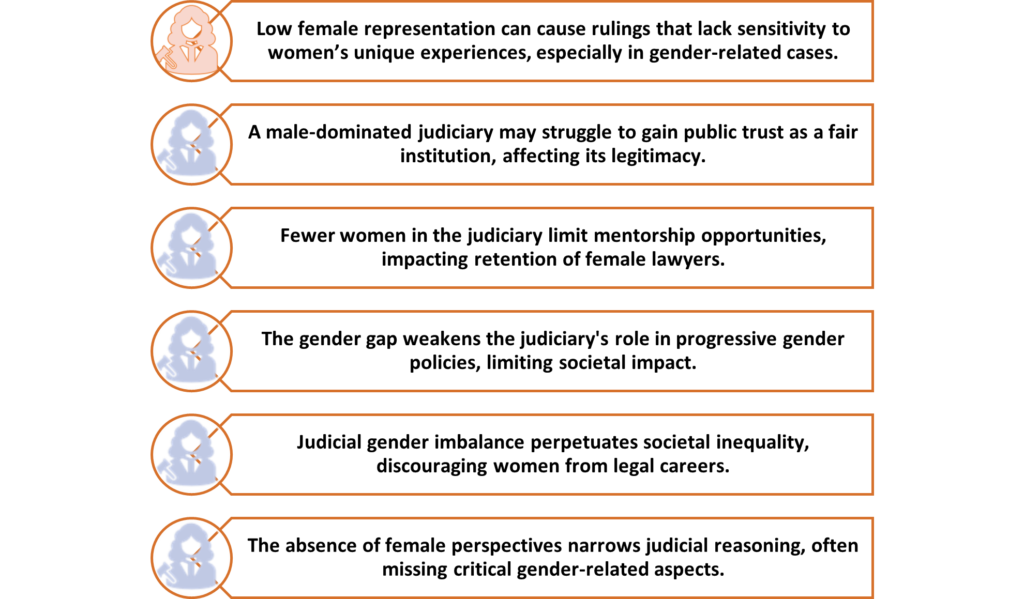(General Studies II – Polity Section – Indian Constitution—Historical Underpinnings, Evolution, Features, Amendments, Significant Provisions and Basic Structure; Separation of Powers between various organs Dispute Redressal Mechanisms and Institutions.)
- The 2023 “State of the Judiciary” report shows that 36.3% of district court judges are women, this number sharply decreases to 13.4% in High Courts and 9.3% in the Supreme Court.
- Certain states, including Bihar and Odisha, have minimal female representation in these critical roles, emphasizing systemic and structural barriers.
Key Challenges to Women’s Representation:
- Structural Barriers
- Patriarchal System: A male-dominated judiciary fosters an “old boys’ club” mentality, often leaving women isolated from essential professional networks and advancement opportunities.
- Opaque Recruitment Processes: Collegium system for judicial appointments lacks transparency, with no clear criteria for selection. This opacity has led to biases, often favoring male candidates over qualified female candidates.
- Environmental Challenges
- Hostile Work Environment: Women often encounter sexism in the judiciary, facing daily interactions that can undervalue their contributions. This negative atmosphere discourages retention.
- Inadequate Infrastructure: A 2019 survey by Vidhi Centre for Legal Policy revealed that nearly 22% of district courts lack women’s washrooms, creating uncomfortable conditions that deter women from judicial roles.
- Societal Expectations and Responsibilities
- Domestic and Family Responsibilities: Traditional gender roles add to the burdens faced by women in balancing professional duties with family responsibilities.
- Lack of Family-Friendly Policies: Minimal maternity leave, rigid transfer policies, and limited flexibility exacerbate the challenges women face, making sustained career growth in the judiciary difficult.
- Representation Gaps in Higher Judiciary
- Low Representation: Only 13% of High Court and 9% of Supreme Court judges are women, which results in fewer role models and mentors for female lawyers.
- Glass Ceiling Effect: Women often face barriers in rising to leadership positions within the judiciary due to gender biases and lack of support in decision-making roles.
IMPACT OF LACK of REPRESENTATION:

Suggested Solutions:
- Transparent Recruitment Processes
- Reforms to the Collegium System: Implementing clear criteria and a transparent process for judicial appointments overseen by a diversified committee that includes women, which could help mitigate bias and make recruitment fairer and more gender-sensitive.
- Gender-Sensitive Policies
- Flexible Judicial Service Rules: Judicial Service Rules in many states require ‘continuous’ practice, disadvantaging women who may have career breaks due to family commitments. Revising these rules to accommodate such breaks would expand the pool of eligible women candidates.
- Supportive Transfer and Promotion Policies: Reforms to make transfer policies more considerate of family obligations and gender-specific challenges would ensure more women remain and progress in their careers within the judiciary.
- Enhanced Infrastructure and Amenities
- Basic Facilities: Ensuring dedicated restrooms, crèches, and feeding rooms in court complexes is crucial. Currently, many courts lack these amenities, impacting women’s productivity and work-life balance.
- Improved Work Environment: A more supportive and inclusive workplace with family-friendly amenities would aid retention. Initiatives such as setting up crèches, as seen in the Delhi High Court, should be expanded to other courts.
- Gender-Sensitive Training
- Inclusion of Women in Policy-Making Roles: Female representation on committees for judicial academies, court registries, and infrastructure policy-making should be increased to ensure gender-sensitive planning.
- Bias-Reduction Training: Training sessions on gender sensitivity and unconscious bias can help address deep-seated prejudices. Regular workshops and mentorship programs can encourage inclusivity within court environments.
- Promoting Role Models and Mentors
- Women’s Leadership Programs: High Courts should actively promote more women to senior roles, creating mentors and role models for aspiring female lawyers and judges. These role models play a crucial part in inspiring future generations.
Increasing women’s representation in India’s judiciary is essential to fostering a fair and inclusive judicial system. By focusing on transparent recruitment, better infrastructure, and a more inclusive work environment, India can build a judiciary that not only reflects its population but also enhances the quality and equity of justice delivery.





